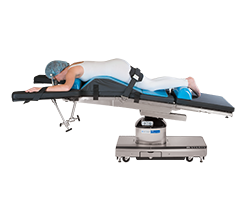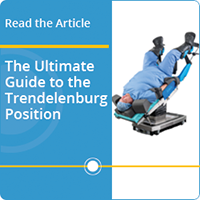Knowledge Center
March 8, 2021
The Ultimate Guide to the Prone Position
What is the Prone Position?

The Prone position is a patient position used during surgical procedures that provide surgical access to the dorsal aspects of the patient’s body.1 In the prone position, the patient is positioned face-down with their head in a neutral position without excessive flexion, extension, or rotation. The patient’s arms should be abducted less than 90 degrees with the elbows flexed and palms down to maintain neutral alignment of the arms and wrists. Some common procedures that are performed while the patient is in the prone position include spine and neck surgeries, neurosurgeries, colorectal surgeries, vascular surgeries, and tendon repairs.1,2
When Would You Put a Patient in the Prone Position?
The prone position is often used for spine and neck surgeries, neurosurgery, colorectal surgeries, vascular surgeries, and tendon repairs. The prone position produces an increase in functional residual capacity and alterations in the distribution of both ventilation and perfusion throughout the lungs.1
When positioning a patient in prone, surgical staff should use safe practices and guidelines:
- Use chest supports that extend from the clavicle to the iliac crest
- Ensure the breast, abdomen, and genitals are free from pressure
- Pad the patient’s knees
- Elevate the patient’s toes off the bed with padding under the shins
- Use a face positioner when the patient’s head is in midline
- Prevent direct pressure on the patient’s eyes
- Ensure a gurney is always readily accessible to reposition the patient from the prone position to the supine position if cardiopulmonary resuscitation becomes necessary
As with all surgical positions, surgical staff should be aware of risks to the patient in the prone position. The patient’s face should be monitored when in the prone position. Pressure should be kept off of the patient’s eyes, cheeks, and ears. At a minimum, four people should be available when turning a patient prone and both the cart and Operating Room table should be locked.
Complications associated with prone position include:1,2
- Increased abdominal pressure
- Increased bleeding
- Compartment syndrome
- Nerve injuries
- Cardiovascular compromise
- Ocular injuries
- Venous air embolism
Advantages of the Prone Position
The prone position offers surgical access to the dorsal (posterior) aspects of the patient’s body, such as the spine, neck, and shoulders. The prone position produces an increase in functional residual capacity and alterations in the distribution of both ventilation and perfusion throughout the lungs. This leads to an improvement in the ventilation/perfusion matching and consequently, an improvement in oxygenation.1
Prone Position vs. Supine Position
| Prone | Supine | |
|---|---|---|
| Positioning | The patient is face-down. The patient’s arms are extended and secured on armboards at a lower level than the chest. The arms are abducted less than 90 degrees with the elbows flexed and palms down to maintain neutral alignment of the arms and wrists. The arms may also be tucked at the patient’s side. The patient’s head is in a neutral position without excessive flexion, extension, or rotation. | The patient is face-up, with their head resting on a pad positioner or pillow and their neck in a neutral position. The patient’s arms are in a neutral thumb-up or supinated position may be tucked at their sides or abducted to less than 90 degrees on armboards. |
| Common Procedures |
|
|
| Common Equipment Used | ||
| Potential Risks |
|
|
| Variations |
|
|
Prone Position Supporting Devices
X-ray Tops – The removable and radiolucent X-ray Tops mount onto surgical tables to provide space to insert flat X-ray cassettes from the head, foot, or side of the table. The X-ray Tops add two inches of elevation to tabletops for procedures that require X-ray imaging.
Anesthesia Armboards - Lightweight and carbon fiber, these Anesthesia Armboards are designed to allow access for anesthesia caregivers during a procedure while a patient is in the prone position. The Anesthesia Armboard easily attaches to any standard siderail with its integral attachment clamp and is enhanced for durability with protective edging to safeguard against damage.
ELITE™ Prone Headrest – The unique molded design of the ELITE Prone Headrest provides prone head positioning and protection of the face while allowing for easy endotracheal tube access. This headrest is reusable and compatible with all surgical tables.
ELITE™ Prone Positioner – Ideal for spinal procedures, the ELITE Prone Positioner is designed to provide proper patient alignment in the prone position. It can be used in conjunction with the Prone Headrest and Flat-Bottom Chest Roll.
ELITE™ Flat-Bottom Chest Roll – With an anatomically specific molded construction, the Flat-Bottom Chest Roll can be used for a patient in the prone or lateral position.
Patient Restraint Strap - Patient Restraint Strap is a reinforced synthetic elastomer belt and strap with quick-release clamps for easy yet secure, adjustable positioning on the surgical table's siderails. The strap is compatible for use with all surgical tales and table extensions with siderails.
Conclusion
A very common patient position, the prone position allows for ideal surgical access for the dorsal aspects of the patient’s body. Surgical staff should consider risks and complications associated with the prone position such as increased intra-abdominal pressure, increased bleeding, abdominal compartment syndrome, limb compartment syndrome, nerve and pressure injuries, and cardiovascular compromise, among others.
Variations to the prone position include the Knee-Chest, Kneeling, and Jackknife (Kraske) positions.
Regardless of what position is being used for a patient during a procedure, it’s important to follow best practices for positioning.1 Surgical Staff should always refer to their facility's positioning policies, procedures and training when positioning a patient.
- Have an adequate number of personnel, devices, and equipment available during positioning activities helps to ensure patient and personnel safety.
- Respect the patient’s dignity and privacy during positioning: only necessary personnel in the room when the patient is exposed.
- Maintain the patient in a natural neutral alignment. Keep the patient’s head and neck in a neutral position without extreme lateral rotation and avoid hyperextending.
- Verify the patient's complete body is in physiologic alignment and that the hands, fingers, feet, and toes are protected from surgical table articulations.
- Operating Room staff should always use safe body mechanics during transfers and positioning.
- Ensure that the patient is not in contact with any metal portions of the surgical table or positioning devices.
- Never exceed the weight limits for the table or the accessories used and always follow the manufacture’s guidelines and recommendations when using the surgical table and accessories.
- Inspect all equipment, pads and accessories before use and replace them as needed.
Contributors to This Article
Lena Elias-Fogle, BSN RN, CNOR
Director, Global Clinical Solutions
Lena is a seasoned healthcare leader with extensive experience leading complex perioperative environments as well as new program development, continuous process improvement, clinical outcomes, operational excellence, and stakeholder experience.
References
1 Guideline for positioning the patient. (2017). AORN Journal, 105(4), P8-P10. doi:10.1016/s0001-2092(17)30237-5
2 Rothrock, J. C. (2011). Alexander's care of the patient in surgery (14th ed.). St. Louis, MO: Mosby.
3 Patient positioning during anesthesia: Supine position. (2016, December 20). Retrieved from http://www.clinicalpainadvisor.com/anesthesiology/patient-positioning-during-anesthesia-supine-position/article/582929



